
ABM (ABM)
We’re cautious of ABM. Its sales have underperformed and its low returns on capital show it has few growth opportunities.― StockStory Analyst Team
1. News
2. Summary
Why We Think ABM Will Underperform
With roots dating back to 1909 as a window washing company, ABM Industries (NYSE:ABM) provides integrated facility management, infrastructure, and mobility solutions across various sectors including commercial, manufacturing, education, and aviation.
- Investment activity picked up over the last five years, pressuring its weak free cash flow profitability
- Poor expense management has led to an adjusted operating margin that is below the industry average
- The good news is that its economies of scale give it some operating leverage when demand rises


ABM’s quality isn’t up to par. We’re redirecting our focus to better businesses.
Why There Are Better Opportunities Than ABM
High Quality
Investable
Underperform
Why There Are Better Opportunities Than ABM
At $43.94 per share, ABM trades at 11x forward P/E. This multiple is cheaper than most business services peers, but we think this is justified.
Cheap stocks can look like a great deal at first glance, but they can be value traps. They often have less earnings power, meaning there is more reliance on a re-rating to generate good returns - an unlikely scenario for low-quality companies.
3. ABM (ABM) Research Report: Q2 CY2025 Update
Facility services provider ABM Industries (NYSE:ABM) reported Q2 CY2025 results exceeding the market’s revenue expectations, with sales up 6.2% year on year to $2.22 billion. Its non-GAAP profit of $0.82 per share was 13.6% below analysts’ consensus estimates.
ABM (ABM) Q2 CY2025 Highlights:
- Revenue: $2.22 billion vs analyst estimates of $2.16 billion (6.2% year-on-year growth, 3% beat)
- Adjusted EPS: $0.82 vs analyst expectations of $0.95 (13.6% miss)
- Adjusted EBITDA: $125.8 million vs analyst estimates of $132.5 million (5.7% margin, 5.1% miss)
- Management reiterated its full-year Adjusted EPS guidance of $3.72 at the midpoint
- Operating Margin: 3.8%, up from 1.8% in the same quarter last year
- Free Cash Flow Margin: 6.8%, up from 3.1% in the same quarter last year
- Organic Revenue rose 5% year on year vs analyst estimates of 2.8% growth (223.5 basis point beat)
- Market Capitalization: $2.99 billion
Company Overview
With roots dating back to 1909 as a window washing company, ABM Industries (NYSE:ABM) provides integrated facility management, infrastructure, and mobility solutions across various sectors including commercial, manufacturing, education, and aviation.
ABM operates through five distinct business segments, each targeting specific market sectors. The Business & Industry segment delivers janitorial, facilities engineering, and parking services for commercial properties, sports venues, and healthcare facilities. For manufacturing clients, ABM handles specialized facility services tailored to production environments and data centers. Its Education segment maintains school and university campuses with custodial, landscaping, and facilities management services.
The Aviation segment supports airlines and airports with a range of services from passenger assistance to cabin maintenance and transportation logistics. Meanwhile, the Technical Solutions segment focuses on infrastructure projects including electrical services, EV charging station installation, and microgrid systems design.
A typical ABM client might be a large corporate office complex that contracts the company to handle all facility maintenance, from daily cleaning to HVAC system management, allowing the client to focus on their core business rather than building operations. A university might rely on ABM to maintain grounds, clean buildings, and manage parking operations across an entire campus.
The company generates revenue primarily through monthly fixed-price contracts, square-foot pricing arrangements, cost-plus models, and transaction-based services. These contracts are typically secured through competitive bidding processes and can range from basic janitorial services to comprehensive facility management solutions.
ABM enhances its service offerings with proprietary programs like ABM EnhancedClean and ABM EnhancedFacility, which provide standardized approaches to cleaning and maintenance. The company has also expanded its technological capabilities through acquisitions, such as Quality Uptime Services, which strengthened its position in critical power infrastructure maintenance for data centers.
4. Industrial & Environmental Services
Growing regulatory pressure on environmental compliance and increasing corporate ESG commitments should buoy the sector for years to come. On the other hand, environmental regulations continue to evolve, and this may require costly upgrades, volatility in commodity waste and recycling markets, and labor shortages in industrial services. As for digitization, a theme that is impacting nearly every industry, the increasing use of data, analytics, and automation will give rise to improved efficiency of operations. Conversely, though, the benefits of digitization also come with challenges of integrating new technologies into legacy systems.
ABM Industries competes with other facility services providers such as Aramark (NYSE:ARMK), Sodexo (OTC:SDXAY), ISS A/S (CPH:ISS), and EMCOR Group (NYSE:EME), as well as numerous regional and specialized service providers in each of its business segments.
5. Revenue Growth
Reviewing a company’s long-term sales performance reveals insights into its quality. Even a bad business can shine for one or two quarters, but a top-tier one grows for years.
With $8.63 billion in revenue over the past 12 months, ABM is one of the larger companies in the business services industry and benefits from a well-known brand that influences purchasing decisions.
As you can see below, ABM’s sales grew at a solid 7% compounded annual growth rate over the last five years. This shows it had high demand, a useful starting point for our analysis.
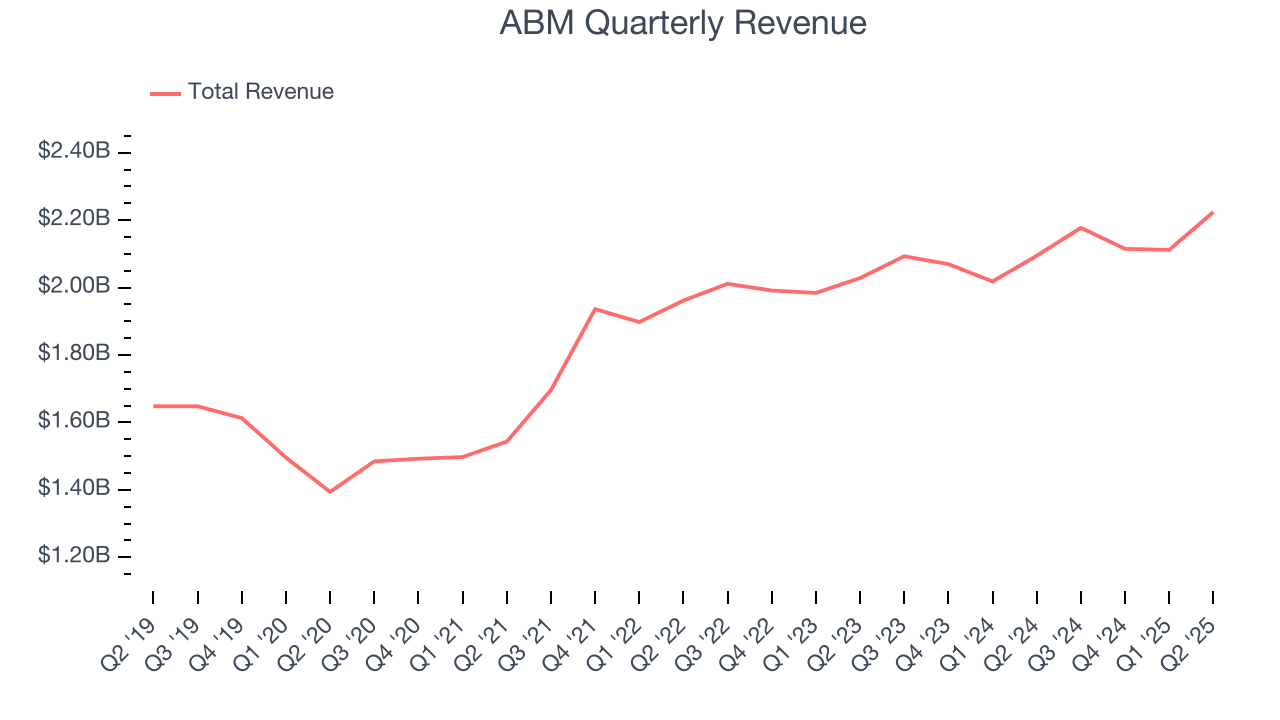
Long-term growth is the most important, but within business services, a half-decade historical view may miss new innovations or demand cycles. ABM’s recent performance shows its demand has slowed as its annualized revenue growth of 3.8% over the last two years was below its five-year trend. 
We can dig further into the company’s sales dynamics by analyzing its organic revenue, which strips out one-time events like acquisitions and currency fluctuations that don’t accurately reflect its fundamentals. Over the last two years, ABM’s organic revenue averaged 3.2% year-on-year growth. Because this number aligns with its two-year revenue growth, we can see the company’s core operations (not acquisitions and divestitures) drove most of its results. 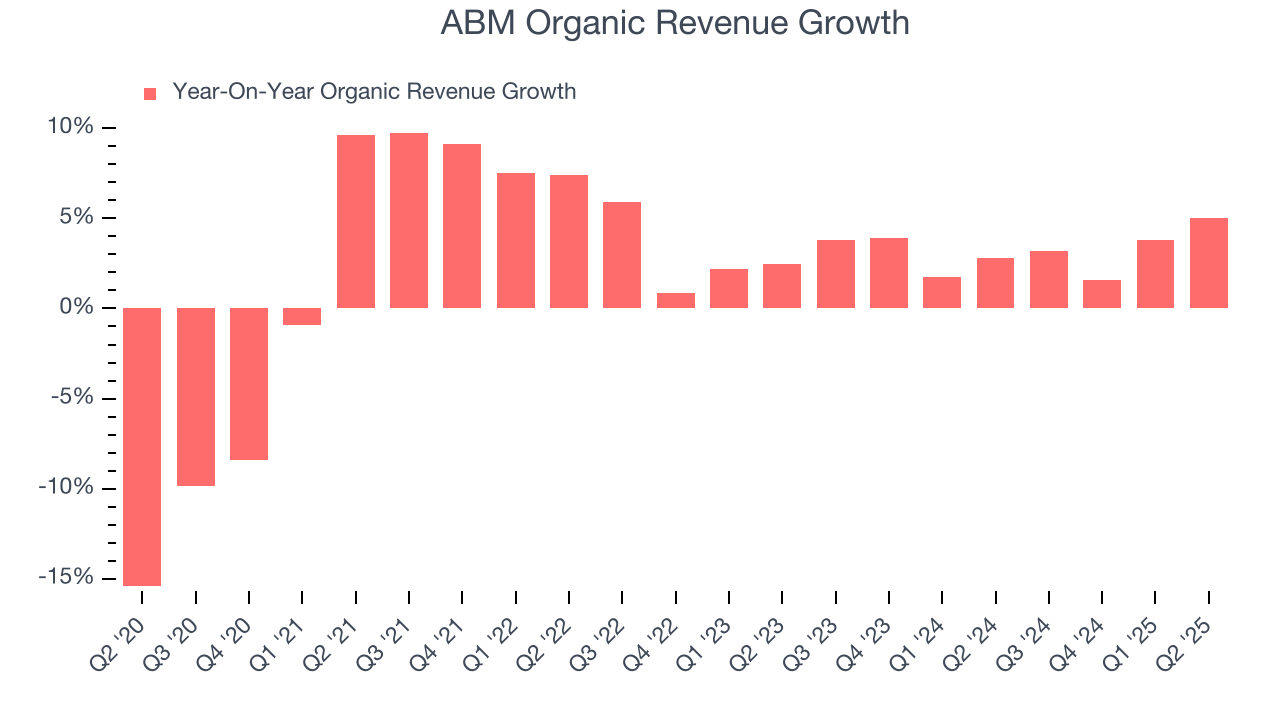
This quarter, ABM reported year-on-year revenue growth of 6.2%, and its $2.22 billion of revenue exceeded Wall Street’s estimates by 3%.
Looking ahead, sell-side analysts expect revenue to grow 2.6% over the next 12 months, similar to its two-year rate. This projection doesn't excite us and indicates its products and services will face some demand challenges.
6. Operating Margin
ABM’s operating margin might fluctuated slightly over the last 12 months but has remained more or less the same, averaging 3.9% over the last five years. This profitability was lousy for a business services business and caused by its suboptimal cost structure.
Analyzing the trend in its profitability, ABM’s operating margin might fluctuated slightly but has generally stayed the same over the last five years. This raises questions about the company’s expense base because its revenue growth should have given it leverage on its fixed costs, resulting in better economies of scale and profitability.
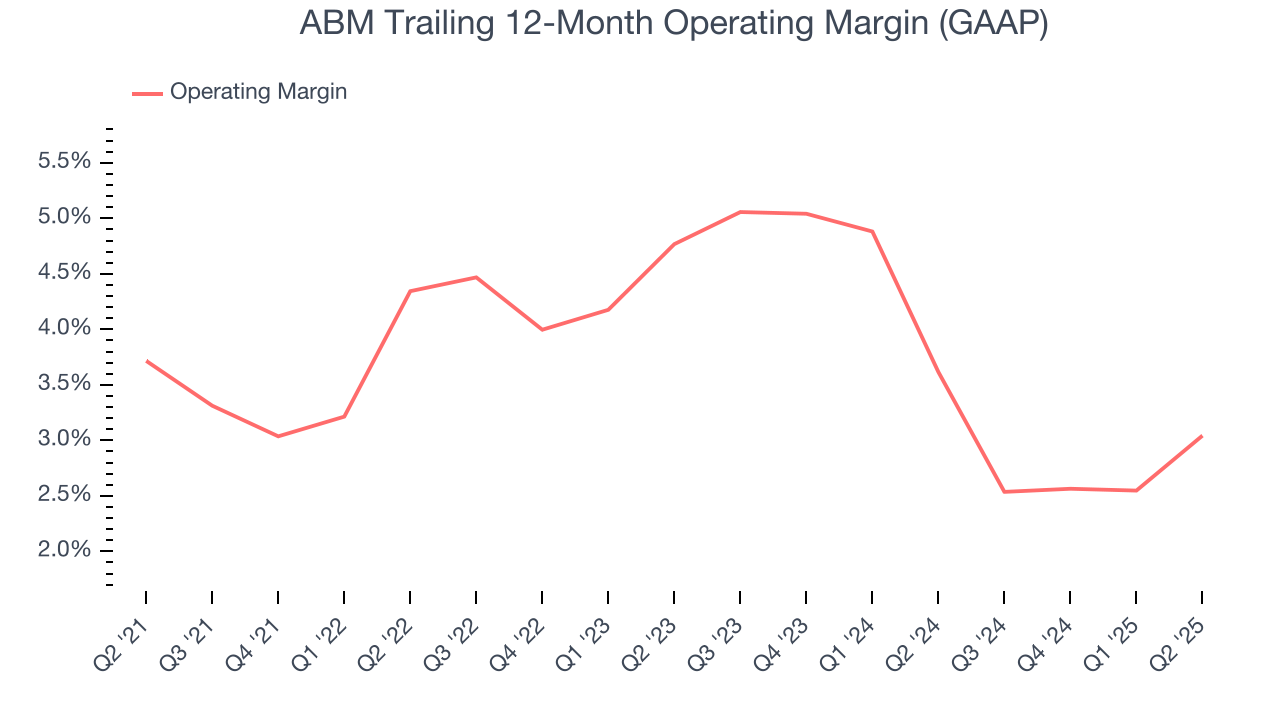
This quarter, ABM generated an operating margin profit margin of 3.8%, up 2 percentage points year on year. This increase was a welcome development and shows it was more efficient.
7. Earnings Per Share
We track the long-term change in earnings per share (EPS) for the same reason as long-term revenue growth. Compared to revenue, however, EPS highlights whether a company’s growth is profitable.
ABM’s decent 7.5% annual EPS growth over the last five years aligns with its revenue performance. This tells us it maintained its per-share profitability as it expanded.
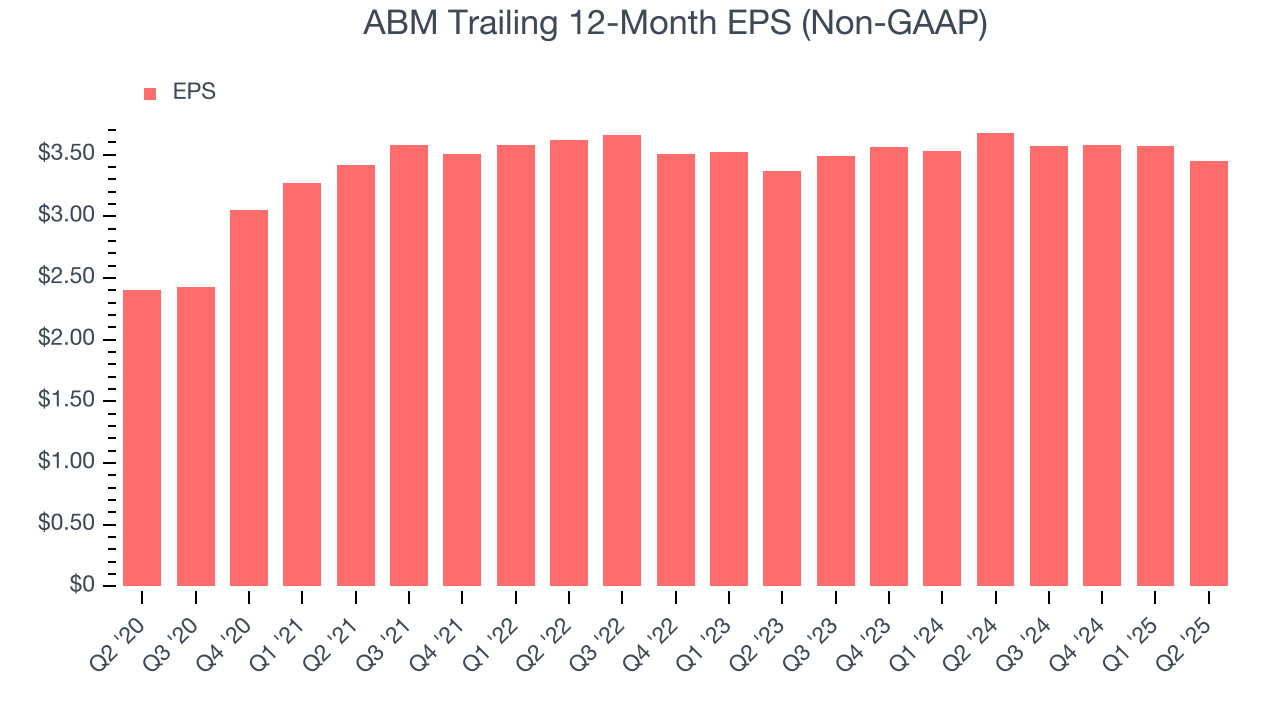
Like with revenue, we analyze EPS over a shorter period to see if we are missing a change in the business.
ABM’s two-year annual EPS growth of 1.2% was subpar and lower than its 3.8% two-year revenue growth.
We can take a deeper look into ABM’s earnings to better understand the drivers of its performance. While we mentioned earlier that ABM’s operating margin expanded this quarter, a two-year view shows its margin has declined. This was the most relevant factor (aside from the revenue impact) behind its lower earnings; interest expenses and taxes can also affect EPS but don’t tell us as much about a company’s fundamentals.
In Q2, ABM reported adjusted EPS of $0.82, down from $0.94 in the same quarter last year. This print missed analysts’ estimates, but we care more about long-term adjusted EPS growth than short-term movements. Over the next 12 months, Wall Street expects ABM’s full-year EPS of $3.45 to grow 16.9%.
8. Cash Is King
Free cash flow isn't a prominently featured metric in company financials and earnings releases, but we think it's telling because it accounts for all operating and capital expenses, making it tough to manipulate. Cash is king.
ABM has shown poor cash profitability over the last five years, giving the company limited opportunities to return capital to shareholders. Its free cash flow margin averaged 2.2%, lousy for a business services business.
Taking a step back, we can see that ABM’s margin dropped by 6.4 percentage points during that time. Almost any movement in the wrong direction is undesirable because of its already low cash conversion. If the trend continues, it could signal it’s becoming a more capital-intensive business.

ABM’s free cash flow clocked in at $150.2 million in Q2, equivalent to a 6.8% margin. This result was good as its margin was 3.7 percentage points higher than in the same quarter last year, but we wouldn’t read too much into the short term because investment needs can be seasonal, causing temporary swings. Long-term trends are more important.
9. Return on Invested Capital (ROIC)
EPS and free cash flow tell us whether a company was profitable while growing its revenue. But was it capital-efficient? Enter ROIC, a metric showing how much operating profit a company generates relative to the money it has raised (debt and equity).
ABM historically did a mediocre job investing in profitable growth initiatives. Its five-year average ROIC was 8.9%, somewhat low compared to the best business services companies that consistently pump out 25%+.
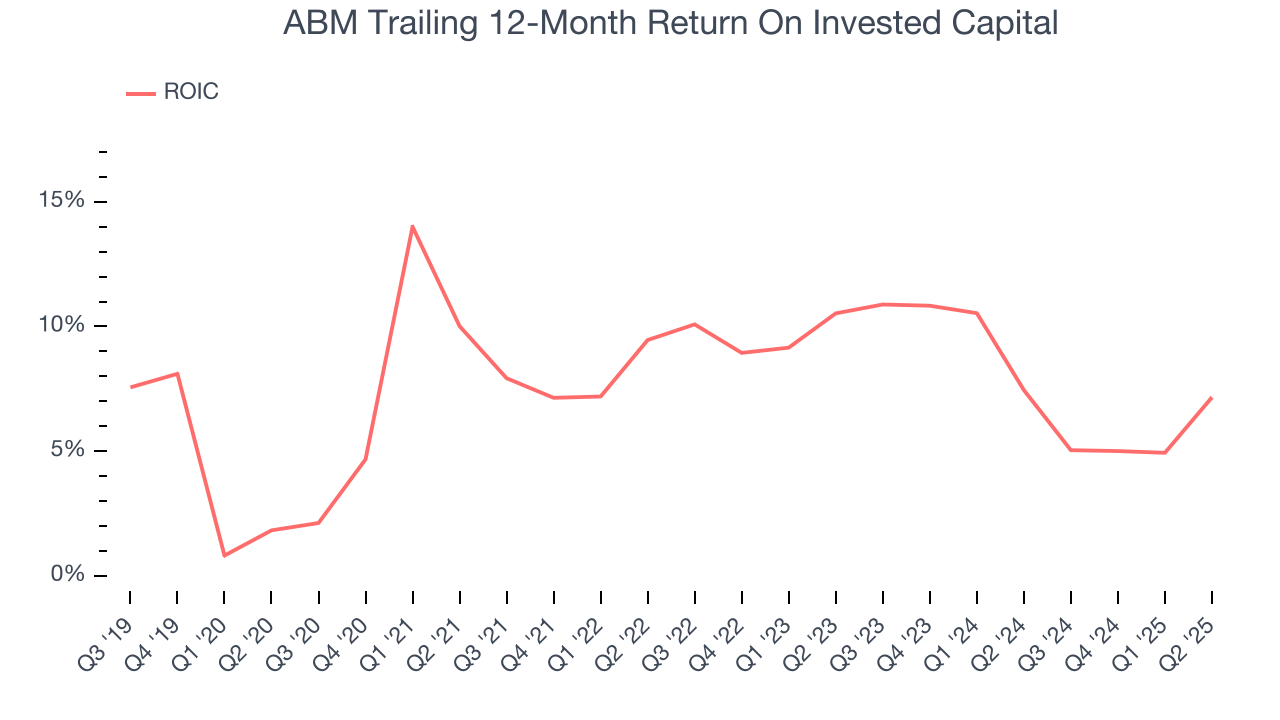
We like to invest in businesses with high returns, but the trend in a company’s ROIC is what often surprises the market and moves the stock price. Unfortunately, ABM’s ROIC averaged 2.4 percentage point decreases over the last few years. Paired with its already low returns, these declines suggest its profitable growth opportunities are few and far between.
10. Balance Sheet Assessment
ABM reported $69.3 million of cash and $1.64 billion of debt on its balance sheet in the most recent quarter. As investors in high-quality companies, we primarily focus on two things: 1) that a company’s debt level isn’t too high and 2) that its interest payments are not excessively burdening the business.
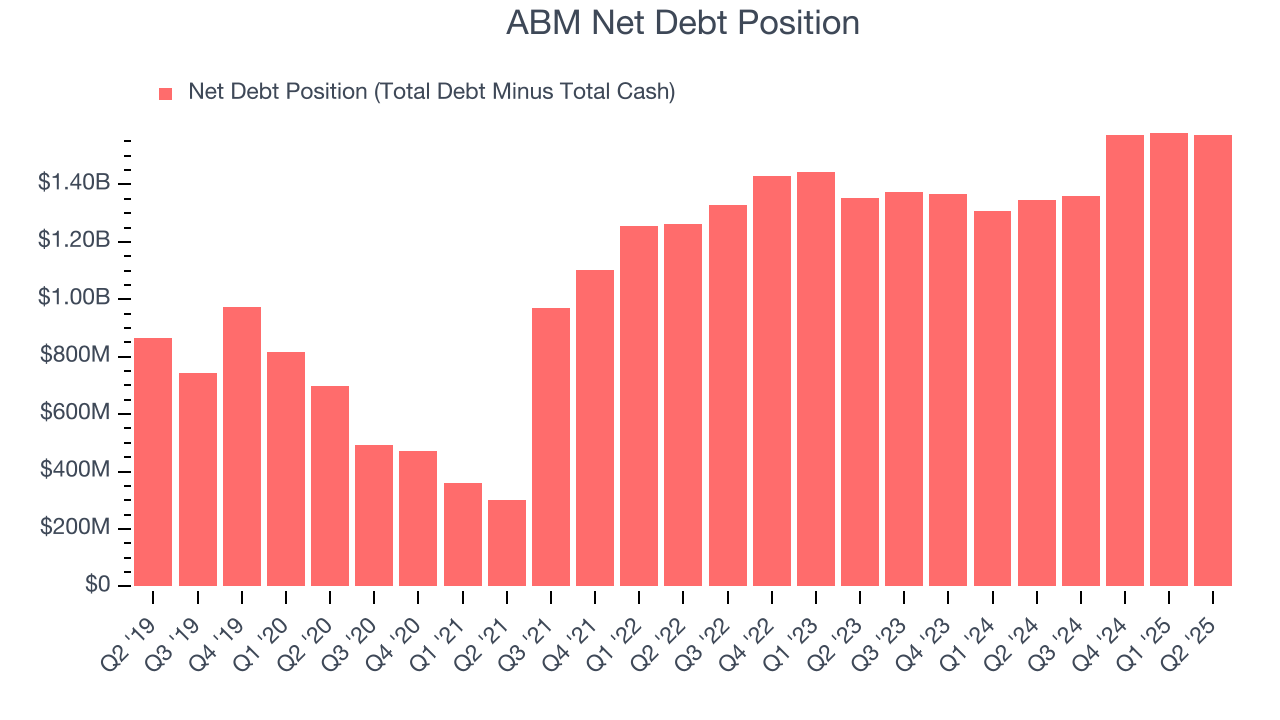
With $500.3 million of EBITDA over the last 12 months, we view ABM’s 3.1× net-debt-to-EBITDA ratio as safe. We also see its $43.4 million of annual interest expenses as appropriate. The company’s profits give it plenty of breathing room, allowing it to continue investing in growth initiatives.
11. Key Takeaways from ABM’s Q2 Results
We enjoyed seeing ABM beat analysts’ organic revenue expectations this quarter. We were also glad its revenue outperformed Wall Street’s estimates. On the other hand, its EPS missed and its full-year EPS guidance fell slightly short of Wall Street’s estimates. Overall, this was a weaker quarter. The stock traded down 4.4% to $46 immediately after reporting.
12. Is Now The Time To Buy ABM?
Updated: December 3, 2025 at 10:51 PM EST
Before deciding whether to buy ABM or pass, we urge investors to consider business quality, valuation, and the latest quarterly results.
ABM isn’t a terrible business, but it isn’t one of our picks. Although its revenue growth was solid over the last five years, it’s expected to deteriorate over the next 12 months and its cash profitability fell over the last five years. And while the company’s projected EPS for the next year implies the company’s fundamentals will improve, the downside is its low free cash flow margins give it little breathing room.
ABM’s P/E ratio based on the next 12 months is 11x. While this valuation is reasonable, we don’t really see a big opportunity at the moment. We're fairly confident there are better investments elsewhere.
Wall Street analysts have a consensus one-year price target of $58 on the company (compared to the current share price of $43.94).
Although the price target is bullish, readers should exercise caution because analysts tend to be overly optimistic. The firms they work for, often big banks, have relationships with companies that extend into fundraising, M&A advisory, and other rewarding business lines. As a result, they typically hesitate to say bad things for fear they will lose out. We at StockStory do not suffer from such conflicts of interest, so we’ll always tell it like it is.












